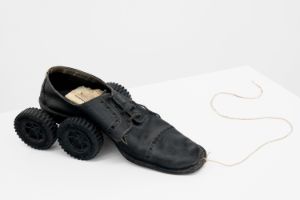Exhibition
Kreuzberg (WT)

Vlassis Caniaris, L’émigrant, 1972. Courtesy the Estate of the Artist and Galerie Peter Kilchmann, Zurich, Paris, photo: Hafid Lhachmi
Nowhere were the social and cultural changes of 1960s and 1970s West Germany more powerfully manifest than in Berlin’s Kreuzberg neighbourhood. Here, the broader transformations reshaping life in the Federal Republic through labour recruitment agreements with countries including Italy, Greece, and Turkey became visible at the local scale. Opening in autumn 2026, the group exhibition Kreuzberg (working title) focuses on the diverse and largely overlooked cultural production on the topic of labour migration and on how artists in the neighbourhood have responded to the tensions and issues of their time.
Gropius Bau, located in Kreuzberg, presents more than 100 works in film, painting, photography, installation and performance that centre the lived realities of labour migrants and their descendants, exploring the struggles for inclusion and equality still being fought today. Featuring both historical and contemporary works, the exhibition demonstrates the international significance of Kreuzberg’s cultural production.
With works by Mehmet Aksoy, Eduardo Arroyo, Akbar Behkalam, Cecilia Boisier, Vlassis Caniaris, Nuray Demir, Grazia Eminente, Abuzer Güler, Azade Köker, Colette Lumiere, Mehrangis Montazami-Dabui, Pınar Öğrenci, Jannis Psychopedis, Metin Talayman, Evanthia Tsantila, Aykan Safoğlu, Monika Sieveking, Setareh Shahbazi & Kaya Behkalam, Hanefi Yeter, Serpil Yeter, among others
Curated by Gürsoy Doğtaş, art historian and Creative Mediator, Manifesta 16, and Patrizia Dander, Deputy Director of Curatorial Affairs, Gropius Bau, with Sonja Borstner and Elena Franziska Setzer, Assistant Curators, Gropius Bau
On the occasion of Kreuzberg, the Stadtmuseum Berlin presents the exhibition Geteiltes Leben at the Museum Ephraim-Palais from 11 September 2026 to 7 February 2027.
Kreuzberg is funded by the Kulturstiftung des Bundes (German Federal Cultural Foundation).